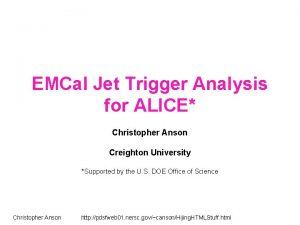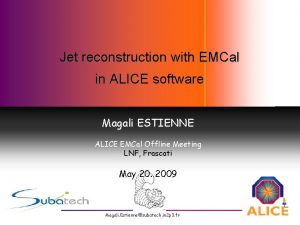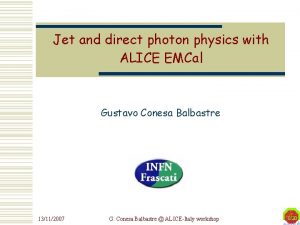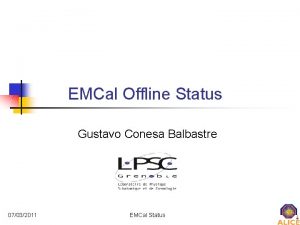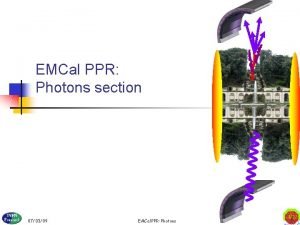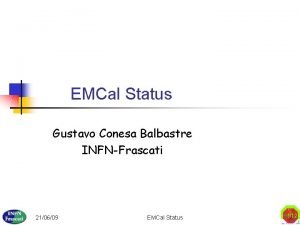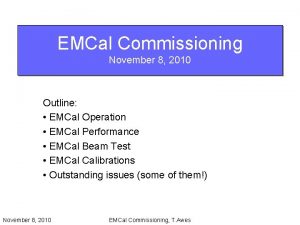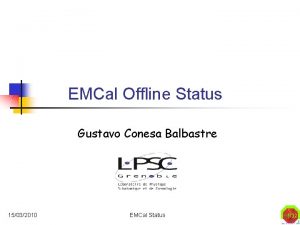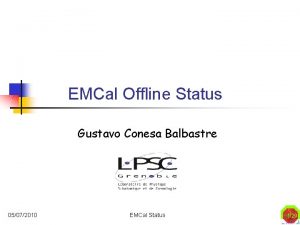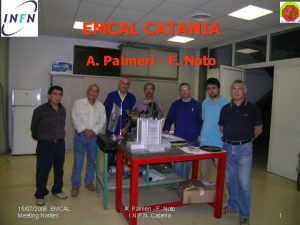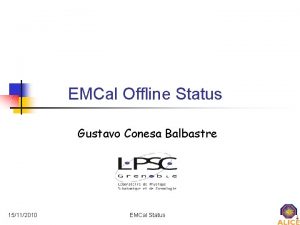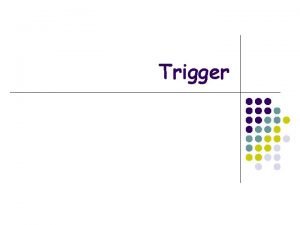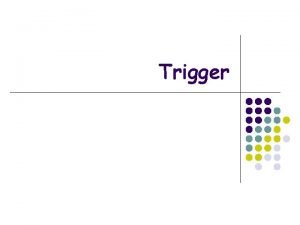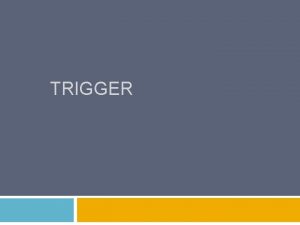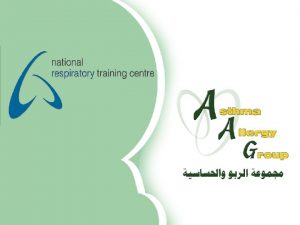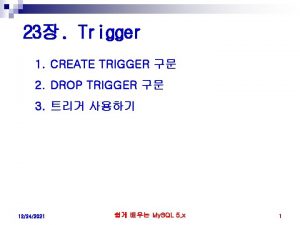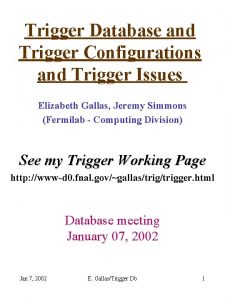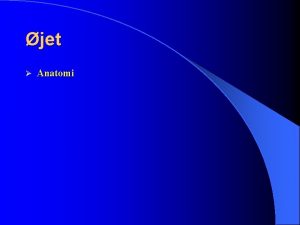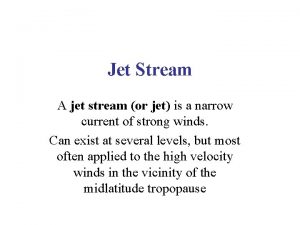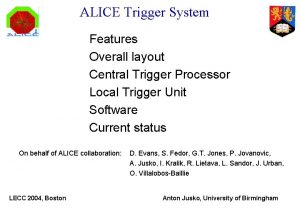Study of jet trigger with ALICE EMCAL for
























- Slides: 24

Study of jet trigger with ALICE EMCAL for Pb. Pb 5. 5 Te. V Masato Sano University of Tsukuba Lawrence Berkeley National Laboratory Research Fellow of the Japan Society for the Promotion of Science

Outline • • • Motivation ALICE Detector Annual jet yield with ALICE : Pb. Pb 5. 5 Te. V ALICE trigger architecture Jet trigger performance : Pb. Pb 5. 5 Te. V Summary 2

Motivation Phys. Rev. Lett. 91(2003) 072304 • RHIC has discovered partonic energy loss in QGP ▫ These results are from the measurement of leading hadrons • If jets can be measured in heavy ion environment, it must be more direct probe for parton energy loss and QGP property itself 3

ALICE Detector • ITS, TPC, TRD : ▫ Δφ<2π、|η|<0. 9 ▫ charged particle momentum determination. ▫ Δp/p 〜 5% at 100 Ge. V/c • EMCAL : ▫ Δφ<110°、|η|<0. 7 ▫ π0 and γ measurement ▫ ΔE/E 〜 11%/√E 4

Annual jet yield at ALICE • Annual jet yield ▫ ▫ Nominal Pb. Pb luminosity 1 running year Binary scaling from p+p (pythia 6) Fast. Jet, anti-kt algorithm is applied for jet reconstruction. ▫ see next talk by D. Sakata • Huge cross section for jet production! 200 k ▫ 200 k jets/year above 100 Ge. V ▫ We have lots of opportunity to use jets as a probe for the properties of QGP • ALICE can’t record all events Need to trigger 5

ALICE trigger architecture • Limitations on data flow ▫ TPC gating frequency (500 Hz) ▫ High level trigger input bandwidth (25 GB/sec) ▫ Data taping bandwidth (1. 25 GB/sec) • We have to select the interesting event efficiently trigger levels in ALICE (L 0(1. 2μs), L 1(6. 6μs), L 2 and High level trigger) • For heavy ion jet measurement with EMCAL, the trigger decision is at L 1 and High level trigger L 1 output should be … < 500 Hz (TPC gating frequency) < 25 GB/sec (High level trigger input bandwidth) Pb. Pb L 0 frequency : 4 k. Hz Data rate : 80 GB/sec High level trigger output should be … < 1. 25 GB/sec (Data taping bandwidth) L 1 High Level Trigger Subsystem information only Fully reconstructed event 6

Jet trigger enhancement with EMCAL • Trigger gain : ▫ Comparison between Jets triggered by and reconstructed with EMCAL and Jets by geometrical triggers and reconstructed with TPC ▫ Applicable for ETJet>100 Ge. V • Jet trigger with EMCAL will enhance high pt jet yield 7

Study of jet trigger performance : Pb. Pb 5. 5 Te. V • To evaluate the jet trigger performance in Pb. Pb collision with ALICE EMCAL, I analyzed the PYTHIA events merged with HIJING events, and applied the L 1 trigger and High level trigger. • L 1 trigger ▫ Patch trigger algorithm is used with subsystem information only (EMCAL, V 0) � Search the square patch which have maximum amplitude in EMCAL acc. � If the amplitude is above threshold, we accept the event EMCAL • High level trigger ▫ Fully reconstructed event information (tracks, clusters in EMCAL, …, etc) ▫ Fastjet Anti-kt algorithm (R=0. 4) � Search the jet which have maximum p. T inside EMCAL acc. � If the p. T is above threshold, we accept the event 8

Background rejection : Pb. Pb 5. 5 Te. V 110 Hz • Left plot : ▫ Maximum patch amplitude distribution weighted by data volume ▫ Background only (HIJING) ▫ Applied cut to reduce data volume by factor 10 • Right plot : ▫ L 1 rejection vs L 1 output frequency ▫ Rejection 10 L 1 output 110 Hz, 8 GB/sec 9

Trigger bias on jet yield : Pb. Pb 5. 5 Te. V • Upper plot : ▫ Jet yield as a function of jet p. T for pythia before/after trigger • Bottom plot : ▫ Jet trigger efficiency • Rejections are 10 and 40 for L 1 trigger and High level trigger respectively 90% ▫ L 1 output : 110 Hz , 8 GB/sec ▫ HLT output : 0. 2 GB/sec • We have 90 % efficiency at above 80 Ge. V/c for these rejections 10

Summary • Jet Trigger performance was evaluated for Pb. Pb 5. 5 Te. V • Jet trigger efficiency is greater than 90% above 80 Ge. V/c with the following rejections L 1 : 1/10 HLT : 1/40 L 1 output HLT output : 8 GB/sec, 110 Hz : 0. 2 GB/sec ▫ These output are satisfied with the requirements (TPC gating frequency, High level trigger input bandwidth and data taping bandwidth) Outlook • Centrality dependence of jet trigger performance • Jet trigger performance with the jet quenching model • Jet trigger performance for pp 11

Back up 12

ALICE Detector • ITS, TPC, TRD : ▫ Δφ<2π、|η|<0. 9 ▫ charged particle momentum determination. ▫ Δp/p 〜 5% at 100 Ge. V/c • EMCAL : ▫ Δφ<110°、|η|<0. 7 ▫ π0 and γ measurement ▫ ΔE/E 〜 11%/√E • JCAL : ▫ Upgrade of electro magnetic calorimeter in ALICE ▫ Sitting on back to back side of existent EMCAL in azimuthal angle ▫ Δφ< 60°, Δη<1. 4 ▫ Dijet, pi 0 -jet, gamma-jet correlation measurement. 13

Annual jet yield at ALICE • Annual yield for various jets are calculated. � Inclusive jet with R=0. 4 in EMCAL � Inclusive jet with R=0. 2 in EMCAL � Jet 1 (in Jcal) – jet 2(in EMCAL) � π0 (in Jcal) – jet (in EMCAL) � γ (in Jcal) – jet (in EMCAL) ▫ Nominal Pb. Pb luminosity for 2 months. ▫ Binary scaling from p+p (pythia 6) ▫ Fast. Jet, anti-kt algorithm is applied for jet reconstruction. • We have lots of opportunity to use jets as a probe for the property of QGP !! Y. Miake, P. Jacobs, H. Yokoyama, M. Sano, 14

L 1 rejection vs Threshold for Pb. Pb 15

Response of the L 1 & HLT • Left plot : for L 1 ▫ ▫ Correlation between “ jet p T in pythia(X axis)” and “amplitude of Max. Patch for L 1 in pythia+Hijing(Y axis)”. For L 1 we can use only partial information like EMCAL cell, V 0 and etc. therefore broad correlation can be seen. • Right plot : for HLT ▫ ▫ Correlation between “jet p T in pythia(X axis)” and “p T of Maximum Jet for HLT in pythia+Hijing(Y axis)”. For HLT we can use the fully reconstruced information, so much sharper correlation can be seen than L 1. 16

Patch size : 0. 1 x 0. 1 17

Patch size : 0. 2 x 0. 2 18

Patch size : 0. 3 x 0. 3 19

Patch size : 0. 4 x 0. 4 20

21

Jet trigger efficiency : pp 5. 5 Te. V 22

V 0 hits vs EMCAL total energy : Background subtraction 23

Jet energy resolution ALICE –EMCAL technical design report 24
 Yelvington jet aviation jet fuel
Yelvington jet aviation jet fuel Egg för emanuel
Egg för emanuel Tobinskatten för och nackdelar
Tobinskatten för och nackdelar Atmosfr
Atmosfr Vad är vanlig celldelning
Vad är vanlig celldelning Programskede byggprocessen
Programskede byggprocessen Personlig tidbok för yrkesförare
Personlig tidbok för yrkesförare Rutin för avvikelsehantering
Rutin för avvikelsehantering Myndigheten för delaktighet
Myndigheten för delaktighet Presentera för publik crossboss
Presentera för publik crossboss Fuktmätningar i betong enlig rbk
Fuktmätningar i betong enlig rbk Iso 22301 utbildning
Iso 22301 utbildning Kung dog 1611
Kung dog 1611 Tack för att ni har lyssnat
Tack för att ni har lyssnat Stig kerman
Stig kerman Referatmarkeringar
Referatmarkeringar Shingelfrisyren
Shingelfrisyren Karttecken
Karttecken Fimbrietratt
Fimbrietratt Mindre än tecken
Mindre än tecken Lufttryck formel
Lufttryck formel Elektronik för barn
Elektronik för barn Borra hål för knoppar
Borra hål för knoppar Bris för vuxna
Bris för vuxna Mat för idrottare
Mat för idrottare

























